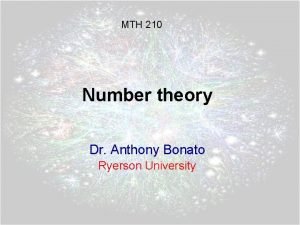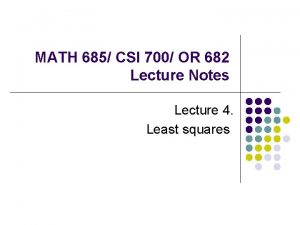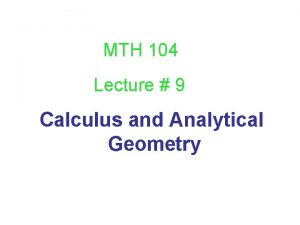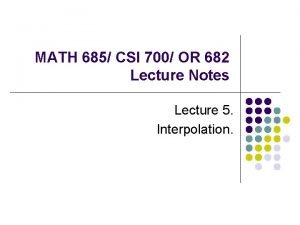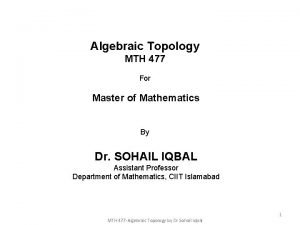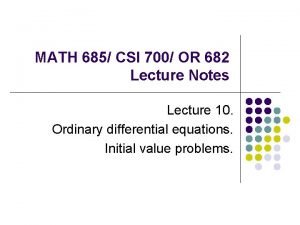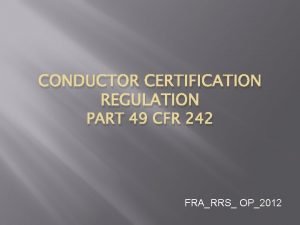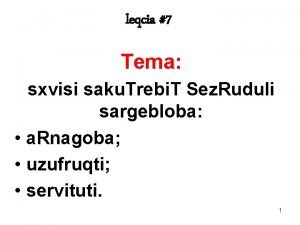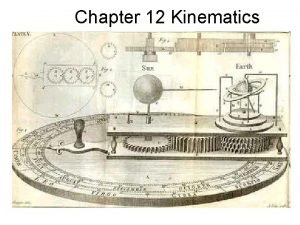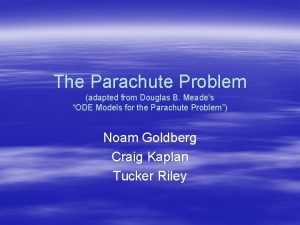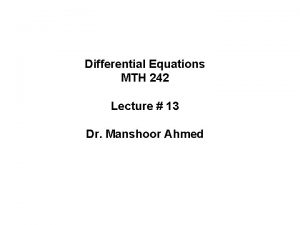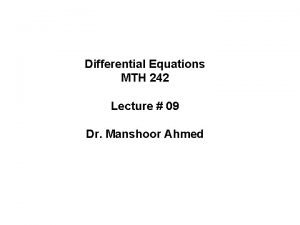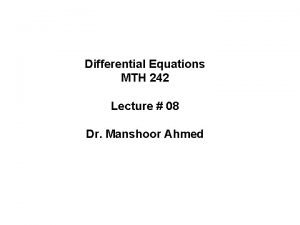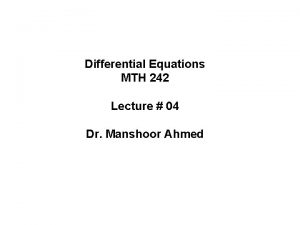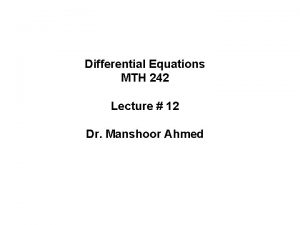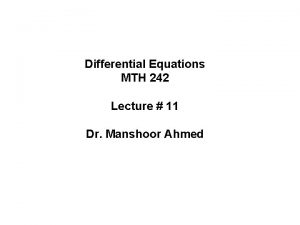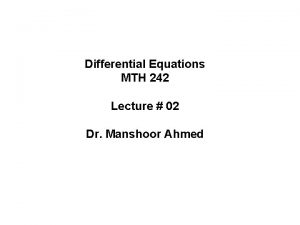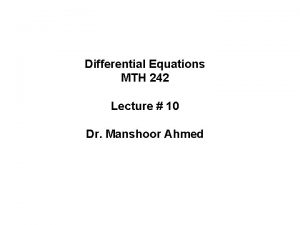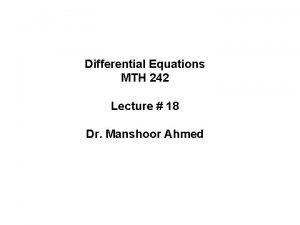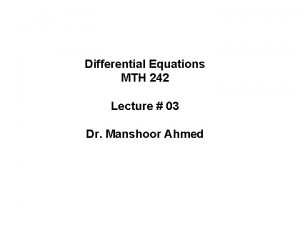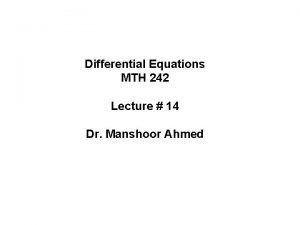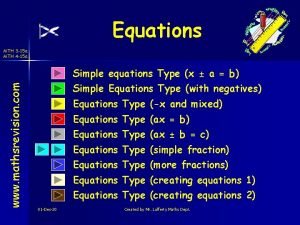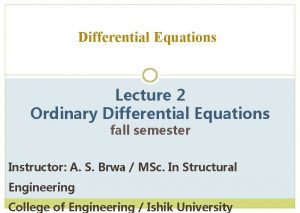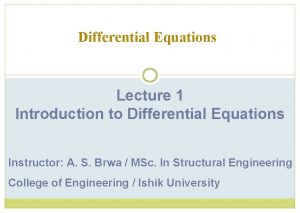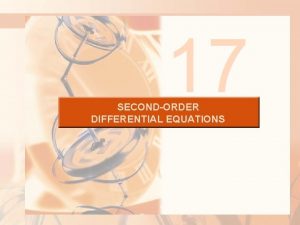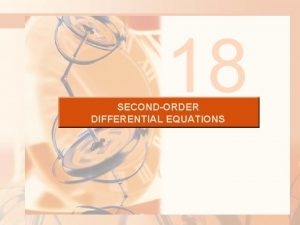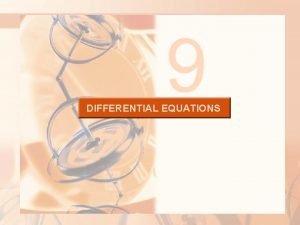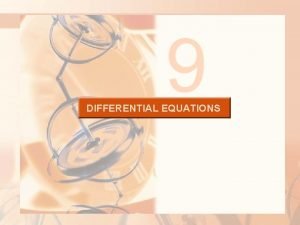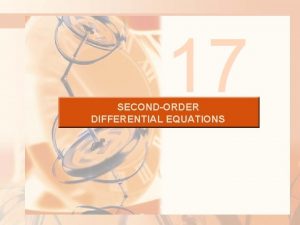Differential Equations MTH 242 Lecture 15 Dr Manshoor



























- Slides: 27

Differential Equations MTH 242 Lecture # 15 Dr. Manshoor Ahmed

Summary(Recall) • Method of variation of parameters for higher order DEs. • Higher order linear Des with variable coefficients • Method of solution for homogeneous DEs with variable coefficients. • Solution of non-homogeneous DEs with variable coefficients. • Some examples.

Modeling with Higher Order Differential Equations

Second order differential equations have a variety of applications in science and engineering. However we explore two of them: The vibration of strings and electric circuits. We are going to consider second order DE with constant coefficients along with initial conditions (at t=0).

1. Spring/ Mass systems To study mechanical vibrations we shall start with the simple mechanical system consisting of a coil spring suspended from a rigid support with a mass attached to the end of the spring. To analyze this mass-spring system we need to recall two laws of Physics. 1. Hook’s Law 2. Newton’s second Law of motion

HOOKE’S LAW: Suppose that • A mass m is attached to a flexible spring is suspended vertically from a rigid support. • The amount of stretch of the spring is S. • The spring itself exerts a restoring force F opposite to the direction of elongation or strech. The Hook’s law states that the force is proportional to the elongation s. F = k. S where k is constant of proportionality, and is called spring constant. For example, if a mass weighing 10 pounds stretches a spring ½ foot, then implies k = 20 lb/ft. Necessarily then, a mass weighing, say, 8 pounds stretches the same spring only foot.

Newton’s second law of motion: If a force F acts upon a body, the acceleration a is produced in the direction of the force whose magnitude is proportional to the magnitude of force. i. e F = ma where m is constant of proportionality and it represents mass of the body.

Differential equation governing the phenomena Suppose a body of mass m is attached to a spring. The spring stretches by an amount s and attains an equilibrium position. At the equilibrium position, the weight is balanced by the restoring force. Thus, the condition of equilibrium is

If the mass is displaced by an amount x from its equilibrium position and then released. The restoring force becomes k(s + x). So that the resultant of weight and the restoring force acting on the body is given by Newton’s second law gives or

Since Hence, Here, the negative indicates that the restoring force of the spring acts opposite to the direction of motion. The displacements measured below the equilibrium position are positive. By dividing with m, the last equation can be written as:


Solution of the equation of motion Consider the equation of simple harmonic motion Then the auxiliary equation is Hence, the general solution of the equation of simple harmonic motion is Alternative form of the solution: Some times it is convenient to write the solution in the following alternative form. Let where

Then So that where is A amplitude of the wave and is phase angle. Here, we can see the usefulness of the alternative form of the solution. For example, • Amplitude A of the free vibration become obvious. • The times when the body crosses equilibrium position are given by where n is non-negative integer

The quadrant in which lies is determined by the signs of and. It is evident from (6) that the motion of a mass in an undamped, free system is simply sine wave or simple harmonic motion. . Time Period Time period and frequency of free vibrations given by

Example 1 Solve and interpret the Initial-value problem Solution The mass on a spring pulled down 10 units below the equilibrium position , holding it until t=0 then releasing it from rest. Here, k=16, The characteristic equation is, Using the initial conditions we have

Therefore solution of the problem is where Or The solution represents a sine wave having amplitude 10 Time period This implies that the wave repeats after every interval. .

Example 2 For the motion described by find the first value of time for which the mass passes through the equilibrium position heading downward. Solution For the mass to pass through equilibrium position putting For n=1 let

For n=2 let is the first time that the mass passes through x=0 heading downward.

Example 3 The period of free undamped oscillations of a mass on a spring is sec. If the spring constant is 12 lb/ft, what is the numerical value of weight ? Solution Here But k=16 and

Example 4 A 64 lb weight attached to the end of a spring stretches it 0. 32 ft. From a position 8 in. above the equilibrium position. The weight is given a downward velocity of 5 ft/s (a) Find the equation of motion. (b) What are the amplitude and period of motion. (c) How many complete vibrations will the weight have completed at the end of seconds? (d) At what time does the weight pass through the equilibrium position heading downward for the second time

(e)At what time does the weight attain its extreme displacement on either side of the equilibrium position. (f) What is the position of the weight at t=3 seconds ? (g) What is the instantaneous velocity at t=3 seconds ? Solution

The characteristic equation is And the solution is By using the initial conditions we get Let

Since lies in fourth quadrant (a) (b) Amplitude= Time Period (c)

(d) For n=1 Let For n=2 let (e) When

(f) (g) Putting t=3 we get


Summary • Application of Higher order differential equations. • Hook’s Law. • Newton’s second law of motion. • Mass-Spring system. • Derivation of equation of motion for simple harmonic motion. • Solution of equation of motion ant alternative form of the solution. • Solution of some problems.
 Mth 210
Mth 210 Mth 210
Mth 210 Mth 685
Mth 685 Mth 104
Mth 104 Mth 105
Mth 105 Mth 685
Mth 685 Mth
Mth Mth 685
Mth 685 01:640:244 lecture notes - lecture 15: plat, idah, farad
01:640:244 lecture notes - lecture 15: plat, idah, farad Et 242
Et 242 Carelli kutztown
Carelli kutztown Step ap 242
Step ap 242 49 cfr part 242
49 cfr part 242 I^242
I^242 Algol typing discipline
Algol typing discipline Et 242
Et 242 Eu confio firmemente
Eu confio firmemente Is-242.b
Is-242.b Manulife viproom
Manulife viproom Muliakan allah bapa
Muliakan allah bapa Schema 242
Schema 242 Carrsh
Carrsh Fpunity
Fpunity Sxvisi saxli
Sxvisi saxli Gezang 239
Gezang 239 Hibbeler
Hibbeler Parachute problem
Parachute problem Euler method formula
Euler method formula
